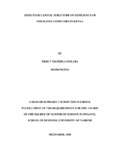| dc.contributor.author | Esilaba, Mercy M | |
| dc.date.accessioned | 2019-01-31T09:25:29Z | |
| dc.date.available | 2019-01-31T09:25:29Z | |
| dc.date.issued | 2018 | |
| dc.identifier.uri | http://hdl.handle.net/11295/106170 | |
| dc.description.abstract | Capital structure plays an important role in firm’s efficiency provided it is utilized efficiently and in an effective manner at its optimal level. However, the questions of what constitutes an optimal capital structure remains unanswered and the most controversial issue in the finance circles. There is no agreement on the nature of effects of capital structure on the efficiency from both the theoretical and different empirical studies. The information asymmetry proposition proposes a negative correlation because companies regardless of their market position would rely on the retained earnings for expansion instead of costly external finance. On the other hand, MM’s tax/ interest shield proposition predicts a positive relationship since at higher income level, corporation would want to utilize more debt finance in their capital structure in order to shield their profits from taxation. This study sought to determine the effect of capital structure on efficiency of insurance firms in Kenya. The population for the study was all the 53 insurance firms operating in Kenya. The independent variables for the study were capital structure as measured by debt ratio, profitability as measured by return on equity, liquidity as measured by current ratio and firm size as measured by natural logarithm of total assets. Firm efficiency was the dependent variable and was measured by the ratio of total revenue to total assets on an annual basis. Secondary data was collected for a period of 5 years (January 2013 to December 2017) on an annual basis. The study employed a descriptive cross-sectional research design and a multiple linear regression model was used to analyze the relationship between the variables. Statistical package for social sciences version 21 was used for data analysis purposes. The results of the study produced R-square value of 0.188 which means that about 18.8 percent of the variation in efficiency of insurance firms in Kenya can be explained by the four selected independent variables while 81.8 percent in the variation of firm efficiency was associated with other factors not covered in this research. The study also found that the independent variables had a weak correlation with firm efficiency (R=0.433). ANOVA results show that the F statistic was significant at 5% level with a p=0.000. Therefore the model was fit to explain the relationship between the selected variables. The results further revealed that only profitability and liquidity produced positive and statistically significant values for this study. Capital structure and firm size were found to be statistically insignificant determinants of efficiency of insurance firms in Kenya. This study recommended that adequate measures should be put into place to improve and grow profitability and liquidity of insurance firms as they significantly influence efficiency. The study was not exhaustive of the independent variables affecting firm efficiency of insurance firms in Kenya and this study recommends that further studies be conducted to incorporate other variables. | en_US |
| dc.language.iso | en | en_US |
| dc.publisher | University of Nairobi | en_US |
| dc.rights | Attribution-NonCommercial-NoDerivs 3.0 United States | * |
| dc.rights.uri | http://creativecommons.org/licenses/by-nc-nd/3.0/us/ | * |
| dc.subject | Efficiency Of Insurance Companies | en_US |
| dc.title | Effects of Capital Structure on Efficiency of Insurance Companies in Kenya | en_US |
| dc.type | Thesis | en_US |



